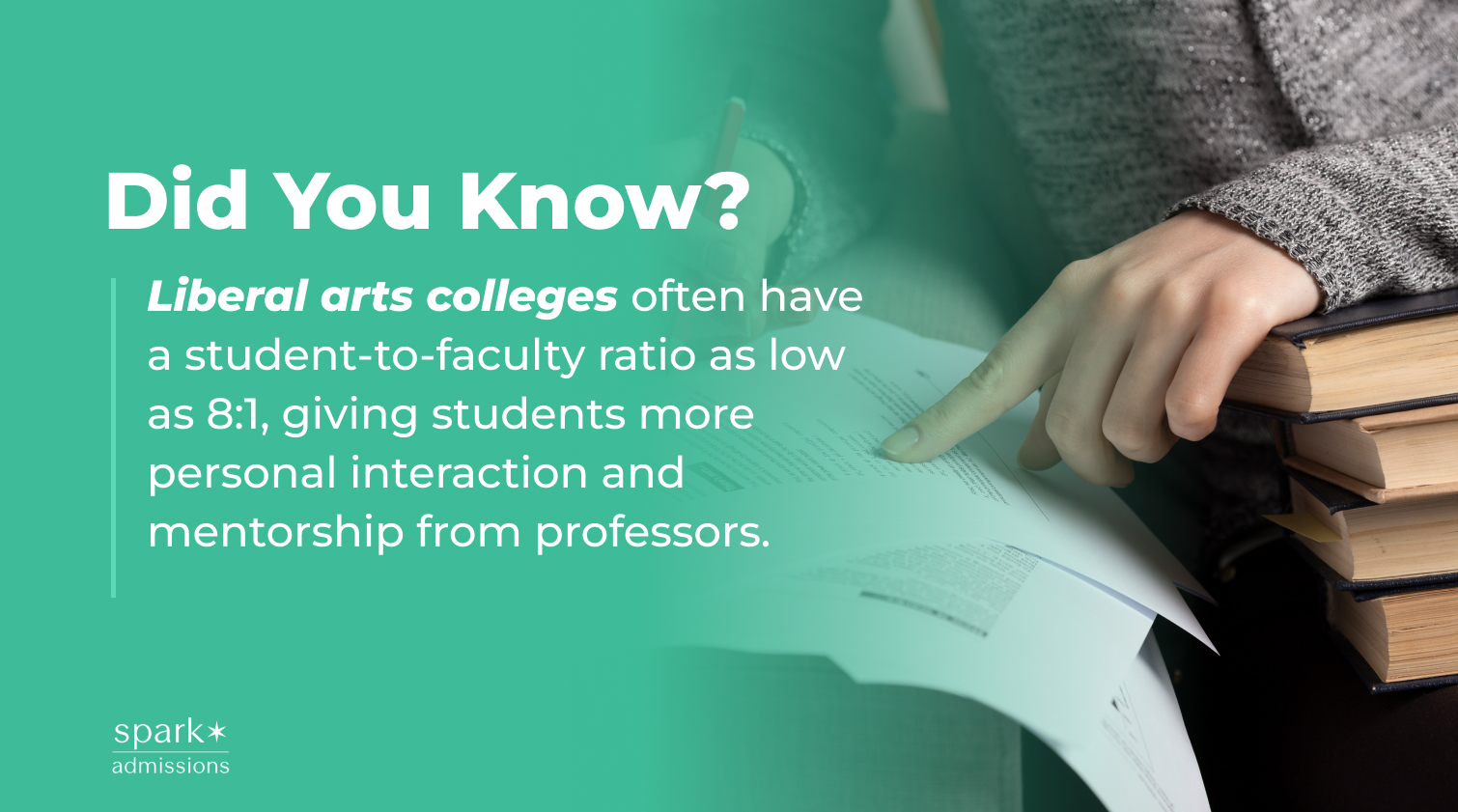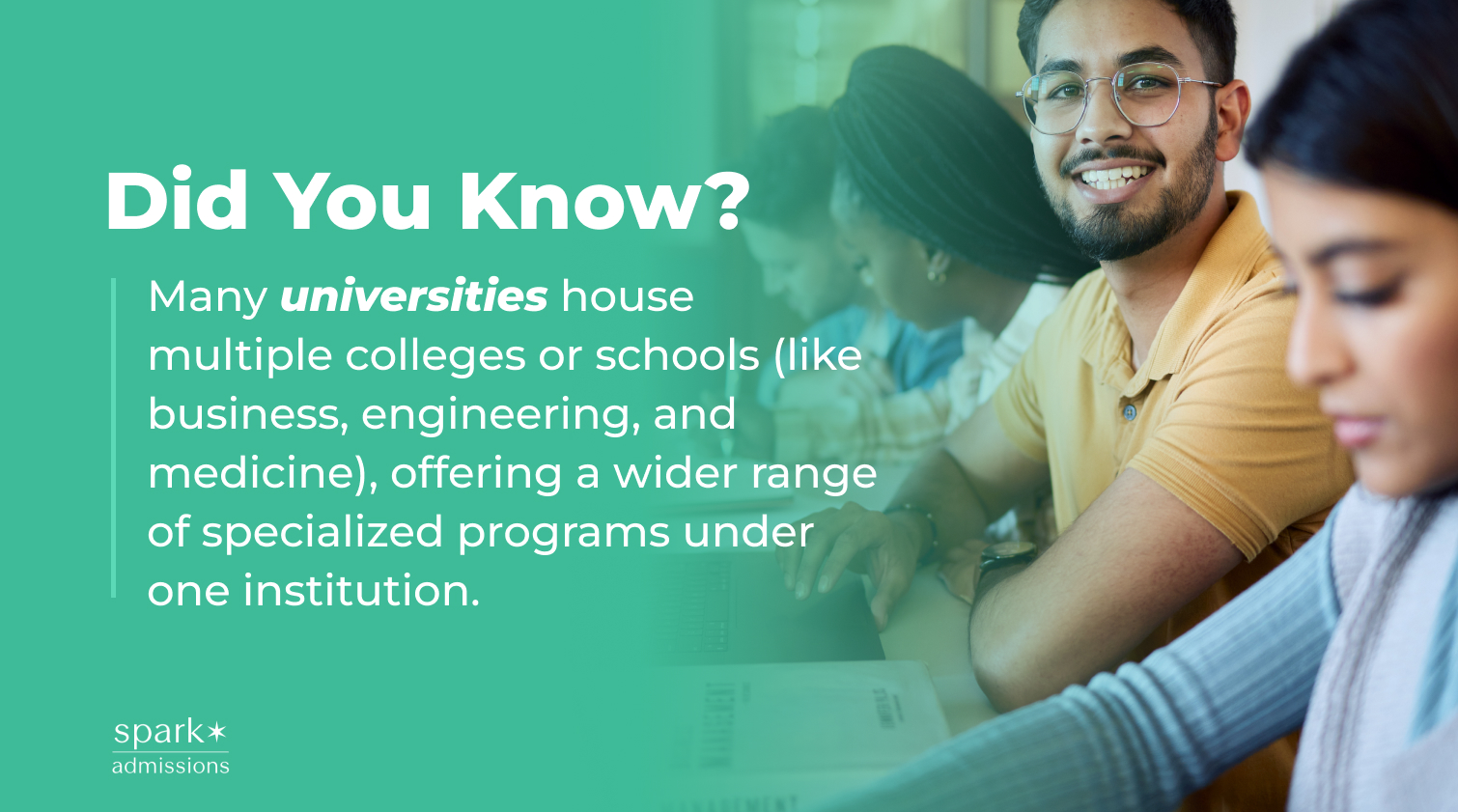- Blog
- > College Admissions
The Difference Between Liberal Arts Colleges and Universities
- Dr. Rachel Rubin
- | July 18, 2025

Choosing a higher education path is one of the most important decisions a student and their family can make. For many, understanding the difference between a liberal arts college and a university can be confusing. While both offer undergraduate degrees, their educational structures, campus life, and academic priorities vary significantly.
This guide will explore the core differences between liberal arts colleges and universities, including academic programs, class sizes, research opportunities, and career preparation. Whether you’re applying for Early Decision, Early Action, or just starting your college search, understanding your options is key to finding the right fit.

What Is a Liberal Arts College?
A liberal arts college is a type of educational institution that emphasizes a broad education across the humanities, social sciences, natural sciences, and creative arts. Rather than focusing on one technical field, a liberal arts education is designed to prepare students with critical thinking skills, communication skills, and a lifelong love of learning.
Liberal arts colleges are typically smaller, offering an intimate learning environment where students receive personal attention from faculty. Many have low student-to-faculty ratios, making them ideal for intellectually curious students who thrive in discussion-based liberal arts classes.
You can build a community at a liberal arts college. Look at some of the other benefits:
Focused on Undergraduate Degrees
One of the most defining features of a liberal arts college is its emphasis on undergraduate education. Professors at these institutions prioritize teaching and mentorship, offering students a highly personalized academic experience. This focus supports the development of essential skills such as analytical thinking, clear communication, and academic curiosity, all of which form the foundation of a successful liberal arts degree.
Intentional Variety in a Liberal Arts School
A liberal arts curriculum also emphasizes a well-rounded education, encouraging students to explore multiple disciplines. Whether you’re majoring in biology or art history, you’ll likely take courses in philosophy, writing, social sciences, and mathematics. This structure promotes versatility, making liberal arts graduates well-prepared for various careers or advanced graduate degrees.
Sought-After Majors in the Liberal Arts Program
Liberal arts colleges are also known for offering robust liberal arts majors in subjects like literature, political science, psychology, and the fine arts. These programs aim to cultivate critical thinking, creativity, and cultural awareness. Students interested in niche fields will often find passionate faculty and tightly knit academic communities in these schools.
A Community of Liberal Arts Students
Another distinguishing trait is the size. Most liberal arts colleges have smaller student bodies, fostering a close-knit campus community and creating strong relationships between students and professors. This intimate environment supports collaborative learning and gives students greater access to leadership roles in campus activities.
Financial Aid for Higher Education
Finally, many liberal arts colleges are private institutions with access to generous financial aid packages, helping make this type of education more affordable for families. Financial aid often plays a key role in the accessibility and appeal of a liberal arts education, especially for students from diverse socioeconomic backgrounds.
Some of the best liberal arts colleges in the U.S. include Amherst College, Williams College, Swarthmore College, and Pomona College. These institutions consistently rank among the nation’s top schools for their rigorous academics, supportive learning environments, and dedication to undergraduate education.

What Is a University Compared to a College?
A university is generally a larger institution that offers both undergraduate and graduate degrees. Universities are often composed of multiple schools or colleges (e.g., business, engineering, education) and tend to emphasize faculty research alongside teaching.
Universities can offer a wide variety of academic programs and specialized training, making them ideal for students interested in professional or technical fields. They also tend to have more extensive facilities and more diverse campus life offerings.
Key Characteristics of Universities:
- Offer both bachelor’s and graduate programs, including doctoral degrees
- Larger class sizes, especially in lower-level courses
- Greater emphasis on faculty-led research projects
- More specialized programs in professional fields like business, law, and medicine
- Wide range of extracurricular activities, career services, and networking opportunities
Examples of well-known universities include Harvard University, Stanford University, and the University of Michigan.
Benefits of Universities
The academic experience is perhaps the most defining difference between a liberal arts college and a university. Now that we’ve learned about liberal arts colleges’ focus, what makes a university different?
Universities Offer a Broader Range of Programs
Universities tend to offer a more extensive list of degree programs, including graduate degrees. This variety can be an advantage for students who want to pursue a specific career path that requires specialized training or advanced study. While many universities also offer liberal arts majors, their academic approach may be more focused on professional development and research.
Larger Classes and More Independence at Universities
Universities often have large lecture halls, especially for introductory courses. Students may need to be more proactive in seeking help or forming relationships with professors. That said, universities typically offer more academic resources and opportunities for experiential learning, such as internships and research opportunities.
Universities Provide a More Diverse Student Body and Activities
Universities often offer a more diverse student body, larger athletic programs, and a broader array of student organizations. The larger scale can mean more opportunities but also a more complex social and academic environment. For students seeking a vibrant and busy campus life, a university may offer the perfect fit.
Universities Offer Professional Programs and Research Experience
For students who know they want to enter a specialized field, such as engineering, nursing, or computer science, a university may offer more direct preparation. The ability to participate in faculty-led research projects, take advantage of niche programs, or enter combined undergraduate and graduate degrees can be a major benefit.
Which One Is Right for You?
When weighing the difference between a liberal arts college and a university, the right choice depends on your goals, interests, and preferred learning style. Ask yourself:
- Do you prefer small, discussion-based classes or large lectures?
- Are you looking for a broad liberal arts education or a focused academic program?
- Would you thrive in a close-knit campus community or prefer a large, vibrant campus life?
- Do you plan to go directly into a career or pursue graduate degrees?
An undergraduate degree equips students with transferable skills like problem-solving, collaboration, and clear communication. These skills are valuable across many career paths, even in fields that aren’t traditionally associated with the liberal arts.
Students who major in a wide array of fields are well-positioned for success in law, business, education, and the nonprofit sector. Many go on to earn graduate degrees at top universities after completing their undergraduate education.
Both types of schools offer excellent pathways to personal growth, academic achievement, and future success, but they do so in different ways. Most college graduates develop transferable skills and receive a well-rounded education, whether from a liberal arts college vs. a university.
Find the Best Fit from a Variety of Liberal Arts Colleges and Universities
Understanding the difference between a liberal arts college and a university is essential when building your college list. Whether you’re drawn to the personalized attention of liberal arts colleges or the broad scope of programs at a university, each path offers unique strengths.
At Spark Admissions, we help students identify the best-fit schools for them, based on their academic interests, learning preferences, and long-term goals. Whether selecting between top liberal arts colleges or evaluating professional degree programs at large universities, our expert consultants provide the guidance you need to make confident decisions.
Need help deciding between a liberal arts college and a university? Contact Spark Admissions for one-on-one college counseling tailored to your future.


